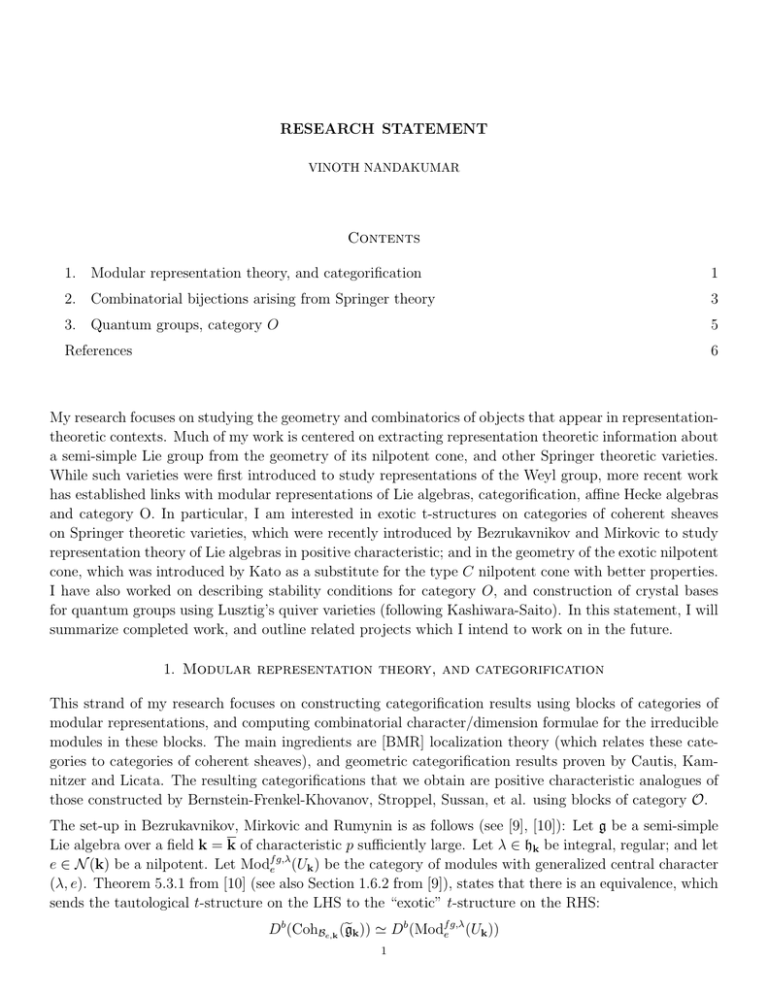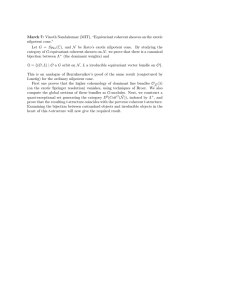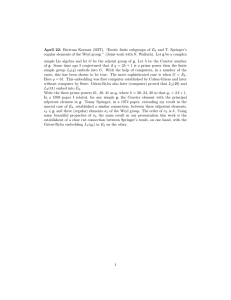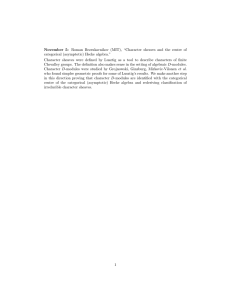RESEARCH STATEMENT Contents 1. Modular representation theory, and categorification
advertisement

RESEARCH STATEMENT
VINOTH NANDAKUMAR
Contents
1. Modular representation theory, and categorification
1
2. Combinatorial bijections arising from Springer theory
3
3. Quantum groups, category O
5
References
6
My research focuses on studying the geometry and combinatorics of objects that appear in representationtheoretic contexts. Much of my work is centered on extracting representation theoretic information about
a semi-simple Lie group from the geometry of its nilpotent cone, and other Springer theoretic varieties.
While such varieties were first introduced to study representations of the Weyl group, more recent work
has established links with modular representations of Lie algebras, categorification, affine Hecke algebras
and category O. In particular, I am interested in exotic t-structures on categories of coherent sheaves
on Springer theoretic varieties, which were recently introduced by Bezrukavnikov and Mirkovic to study
representation theory of Lie algebras in positive characteristic; and in the geometry of the exotic nilpotent
cone, which was introduced by Kato as a substitute for the type C nilpotent cone with better properties.
I have also worked on describing stability conditions for category O, and construction of crystal bases
for quantum groups using Lusztig’s quiver varieties (following Kashiwara-Saito). In this statement, I will
summarize completed work, and outline related projects which I intend to work on in the future.
1. Modular representation theory, and categorification
This strand of my research focuses on constructing categorification results using blocks of categories of
modular representations, and computing combinatorial character/dimension formulae for the irreducible
modules in these blocks. The main ingredients are [BMR] localization theory (which relates these categories to categories of coherent sheaves), and geometric categorification results proven by Cautis, Kamnitzer and Licata. The resulting categorifications that we obtain are positive characteristic analogues of
those constructed by Bernstein-Frenkel-Khovanov, Stroppel, Sussan, et al. using blocks of category O.
The set-up in Bezrukavnikov, Mirkovic and Rumynin is as follows (see [9], [10]): Let g be a semi-simple
Lie algebra over a field k = k of characteristic p sufficiently large. Let λ ∈ hk be integral, regular; and let
e ∈ N (k) be a nilpotent. Let Modfe g,λ (Uk ) be the category of modules with generalized central character
(λ, e). Theorem 5.3.1 from [10] (see also Section 1.6.2 from [9]), states that there is an equivalence, which
sends the tautological t-structure on the LHS to the “exotic” t-structure on the RHS:
Db (CohBe,k (e
gk )) ' Db (Modfe g,λ (Uk ))
1
2
VINOTH NANDAKUMAR
1.1. Two-block nilpotents.
Previous work: In [3] (joint with Rina Anno), we study exotic t-structures in type A, for nilpotents
whose Jordan type has two blocks; our main result is an explicit description of the irreducible objects in
the heart of these t-structure. Let g = slm+2n , let z be the standard nilpotent of type (m + n, n). The
Springer fiber is the variety
Bz = π −1 (z) = {(0 ⊂ V1 ⊂ · · · ⊂ Vm+2n = Cm+2n ) | zVi ⊆ Vi−1 , dim Vi = i}
We will be studying the exotic t-structures on the categories Dn = Db (CohBz (Uz )) (the bounded derived
category of coherent sheaves on the resolution of the Slodowy slice, Uz , supported on Bz ). Using techniques
of Cautis and Kamnitzer from [12], in Theorem 4.26 of [3], we prove that:
Theorem 1.1. Let ATanm be the category with objects {m + 2k} for k ∈ Z≥0 , and the morphisms
between {m + 2p} and {m + 2q} consist of all affine (m + 2p, m + 2q) tangles (ie. a diagram with m + 2p
points on an inner circle, m + 2q points on an outer circle, arcs connecting these endpoints, and a finite
number of circles). Then there is a weak representation of the category ATanm using the categories Dk
(ie. for each affine (m + 2p, m + 2q) tangle α there is a functor Ψ(α) : Dp → Dq , and an isomorphism
Ψ(β) ◦ Ψ(α) ' Ψ(β ◦ α) for each (m + 2q, m + 2r)-tangle β).
We show some compatibility results between this action, and the Baf f -action which can used to define
exotic t-structures. This allows to give the following description of the simple objects (see Proposition
5.10 in [3]); see also Theorem 5.15 of [3], where give explicit combinatorial descriptions of Ext’s between
the simples, and show that the resulting Ext algebra is an annular version of Khovanov’s arc algebra.
Theorem 1.2. Let Cross(n) be the set of affine (m, m + 2n) tangles with n cups, no crossings, and inner
points unlabelled. For each α ∈ Cross(n), we have a functor Ψ(α) : D0 → Dn ; let Ψα = Ψ(α)(C) (noting
that D0 ' Db (Vect)). Then {Ψα | α ∈ Cross(n)} constitute the irreducible objects in Dn0 .
1.2. Ongoing, and future work.
Modular representation theory, and Koszulity of annular arc algebras. In an ongoing project
(see [23]), we re-interpret the above result on the RHS of the [BMR] equivalence. These simple exotic
sheaves correspond to irreducible representations in Modfe g,λ (Uk ). In Proposition 2.8 of [23], we give combinatorial dimension formulae for these irreducible modules, by working on the level of the Grothendieck
group, and using the fact (see Section 6.2 of [10]) that the dimension of an irreducible module M in
the Euler characteristic of Fr∗ FM ⊗ O(λ) (here FM is the corresponding exotic sheaf). We will also
compute character formulae using similar techniques, and to re-interpret Theorem 1.1 above using the
categories Modfe g,λ (Uk ); this is a positive characteristic analogue of the tangle categorification using blocks
of parabolic category O due to Bernstein, Frenkel and Khovanov ([4]), and Stroppel ([30]).
In another ongoing project, we will give a combinatorial re-formulation of Theorem 1.1 using the annular
arc algebras mentioned above (following Khovanov’s construction in [18]); this will give an extension of
Khovanov homology to links in an annulus (and more generally, affine tangles). We will adopt Khovanov’s
TQFT approach, but using “nested co-bordisms” introduced by Stroppel and Webster in [31]. We will also
show that the Koszul dual algebra is isomorphic to an annular version of the KLR-type algebra defined by
Webster in [32]; this will essentially follow once we construct a categorification of the affine tangle calculus
using these algebras, and compare it to Theorem 1.1. It will then follow that Modfe g,λ (Uk ) is equivalent to
the category of modules over this annular KLR-type algebra (which is a positive characteristic analogue
of Webster’s diagrammatic description of two-block singular category O in [32]).
RESEARCH STATEMENT
3
We also expect that it will be possible to extend some of these results for two-block nilpotents to other
nilpotents in type A. The main technical tool we used here is Cautis-Kamnitzer’s categorification of the
intertwiners between sl2 representations in [12]; this is generalized to slk in [13]. While we no longer
expect that the same method will produce all irreducible exotic sheaves for the nilpotent in question, we
do expect that they will give some of them. It will then possible to extract some representation theoretic
information about the corresponding irreducible representations.
Categorification via singular blocks of modular representations
In ongoing work with Gufang Zhao (see page 2 of [22] for the main result), we give a characteristic
p analogue of Bernstein-Frenkel-Khovanov’s categorification of the sl2 -action on (C2 )⊗n using singular
category O. Let g = sln ; the (−n + 2l)-weight space in (C2 )⊗n is categorified by Modfµgl ,0 (Ugk ) where
µl = −ρ + e1 + · · · + el is specifies the singular Harish-Chandra character, and 0 specifies the action of
the p-center. As in [BFK] (see [4]), the maps E and F between these weight spaces are categorified by
the translation functors between these blocks; we first check the sl2 relations on the level of Grothendieck
groups (by verifying them on the spanning set given by Weyl modules). To finish the proof, we show this
constitutes a sl2 -categorification in the sense of Chuang and Rouquier, by checking their criterion.
We plan to show this corresponds to a geometric categorification constructed by Cautis, Kamnitzer,
and Licata, action after it’s transported to the other side under a certain [BMR]-type localization result
proven in [24] (which shows that Modfµgl ,0 (Ugk ) is derived equivalent to the category of coherent sheaves
on the co-tangent bundle to a partial flag variety). The categories appearing in Riche’s equivalence have
Koszul gradings, and this will give a graded version of the above. We also plan to generalize this to
give a categorification of the slk -action on (Ck )⊗n , which should be fairly straightforward. In the [BFK]
framework, more generally one categorify tensor products of wedge powers (as done in Sussan’s thesis),
using parabolic blocks of singular category O. We expect that it is possible to construct a positive
characteristic analogue of this; however, the corresponding geometric statement seems to be much more
delicate.
2. Combinatorial bijections arising from Springer theory
Many aspects of the representation theory of a semisimple Lie group can be seen by studying the geometry
of its nilpotent cone. However, the Springer correspondence in types B, C and D is more complicated
than that in type A in many ways. Kato has introduced the “exotic nilpotent cone”, as a substitute for
the nilpotent cone in type C which mimicks its behaviour and in many cases has better properties.
Let G = Sp2n (C) and g = sp2n (C) be the symplectic group and its Lie algebra (here C2n is equipped
with a symplectic form). Kato’s exotic nilpotent is defined to be N = C2n × N0 where:
N0 = {x ∈ End(C2n ) | x nilpotent, hxv, vi = 0 ∀ v ∈ V}
In [17], Kato shows that the G-orbits on N are in bijection with Qn (the set of bi-partitions of n), and
constructs an analogue of the type C Springer correspondence using the exotic nilpotent cone which is
cleaner than the type C Springer correspondence. In [16], Kato has studied multi-parameter affine Hecke
algebras using the equivariant K-theory of the exotic Steinberg variety (following techniques used by
Kazhdan, Lusztig and Ginzburg).
4
VINOTH NANDAKUMAR
2.1. Previous work. Now let G be any semisimple algebraic group; denote by g its Lie algebra and
N ⊂ g its nilpotent cone. Let Λ+ denote the set of dominant weights for G, and O denote the set of
pairs (O, V ), where O is a G-orbit on N , and V is a finite-dimensional irreducible representation of the
isotropy group Gx of the orbit O, where x ∈ O. Motivated in part by the theory of two-sided cells in
affine Weyl groups, Lusztig and Vogan conjectured (independently) that there is a canonical bijection
between Λ+ and O. Using geometric methods, in [8], Bezrukavnikov proves this conjecture by studying
the irreducible objects in a certain t-structure on Db (CohG (N )). It is also shown in [7] that on the level
∗
∗
of Grothendieck groups, the natural map Db (CohG×C (St)) → Db (CohG×C (N )) sends a canonical basis
element in Haf f either to 0, or to the class of an irreducible object.
Now specialize to G = Sp2n (C); in [19], we follow the method used in [8] to establish an exotic analogue
of this bijection. Let O be the set of pairs (O, L), where O is a G-orbit on N, and L is a finite-dimensional
irreducible representation of the isotropy group Gx of the orbit O (here x ∈ O). In Theorem 4.8 of [19]
we construct a bijection between Λ+ and O.
The quasi-exceptional t-structure on Db (CohG (N)): Let C = Db (CohG (N)). In [16], [17], Kato
e → N; we also have the vector bundle projection
constructs a semi-small resolution of singularities π : N
∗
e
p : N → G/B. Let ONe (λ) = p OG/B (λ), and denote ∇λ = Rπ∗ ONe (λ)[d] where d = dim(N)
. In Section 2
2
of [19], we describe the cohomology of the sheaves ONe (λ). In Theorem 3.16 of [19], we prove that:
Theorem 2.1. There is a unique t-structure on C = Db (CohG (N)), such that ∇λ ∈ C ≥0 and ∇w0 ·λ ∈ C ≤0
for λ ∈ Λ+ .
To prove this, we appeal to the well-established theory of a quasi-exceptional sets in a triangulated
category C; (very similar to that of a highest weight category). It follows general theory that the simple
objects in the heart are also naturally indexed by Λ+ . Meanwhile, applying the theory of perverse coherent
t-structures (see [6]), one obtains another t-structure on Db (CohG (N)). From the general theory, the
irreducible objects in the heart P of this t-structure are parametrized by O (or, more generally, with a
irreducible vector bundle over a G-orbit). In Proposition 4.6 of [19], we prove that:
Theorem 2.2. The perverse coherent t-structure on Db (CohG (N)) coincides with the above quasiexceptional t-structure. Comparing the parametrization of irreducible objects, the desired bijection
between Λ+ and O follows.
2.2. Future work.
In [1], Achar gives an explicit description of the bijection in type A using some complicated combinatorial
algorithms. In future work, I plan to work towards giving a similar description of the bijection constructed
above. After we restrict to pairs on the RHS where the nilpotent orbit lies in N0 ⊂ N, the bijection
should become more tractable, since in this case, the resolutions of these nilpotent orbits are known (and
Achar uses these resolutions in an essential way). This is also closely related to a generalization of the
Lusztig-Vogan conjecture to real groups, for the pair (g, k) with g = sl2n , k = sp2n .
In an separate project, joint with Daniele Rosso and Neil Saunders, I plan to give a geometric construction
of the type C Robinson-Schensted correspondence using the exotic nilpotent cone. Recall that in type A,
motivated by the representation theory of Sn , the Robinson-Schensted correspondence gives an explicit
combinatorial bijection between elements of Sn and and pairs of standard young tableau of fixed shape. In
[29], Steinberg gives a geometric realization of this bijection by parametrizes the irreducible components
RESEARCH STATEMENT
5
e ×N N
e in two different ways, with one giving the LHS of the bijection,
of the Steinberg variety St = N
and the other giving the RHS of the bijection.
While this bijection can be generalized to arbitrary semi-simple Lie groups, in the other classical types the
bijection differs from the version of the Robinson-Schensted correspondence one expects from studying
representations of the Weyl group. However, in type C, by instead studying the geometry of the exotic
e ×N N,
e we expect to recover the type C Robinson-Schensted correspondence.
Steinberg variety St = N
3. Quantum groups, category O
Stability conditions for category O. Inspired by Bridgeland’s theory of stability conditions, in [2],
Anno, Bezrukavnikov and Mirkovic define the notion of a “real variation of stability conditions” on a
triangulated category C (consisting of a collection of t-structures on it, indexed by connected components
in a given hyperplane arrangement in a vector space V , and a “central charge” map Z : V → (K 0 (C)⊗R)∗ ,
e
satisfying some compatibilities). They then give an example of this construction, with C = Db (CohBe (S))
(where Se is the pre-image to the Slodowy slice at e under the Springer map), with the hyperplane
arrangement is the set of affine co-root hyperplanes in V = h∗R ; the central charge map involves taking
the Euler characteristic of tensor products of sheaves with line bundles, the t-structures on are the exotic
t-structures from [9].
In [21], I construct another example using certain sub-quotients of the principal block O0 of BGG category
O for a semi-simple Lie algebra g. For d ∈ Z+ , let O0<d (resp. O0≤d ) be the Serre subcategories consisting
of objects with Gelfand-Kirillov dimension less than (resp. less than or equal to) d; we will be working
with the derived quotients C = Db (O0d ) = Db (O0≤d /O0<d ), with the hyperplane arrangement being V = h∗R
and Σ being the set of linear co-root hyperplanes. Given λ ∈ Λ+ , M ∈ O0d , the central charge map Z
is defined by letting Z(λ)[M ] to be leading coefficient in a certain filtration polynomial for the module
T0→λ M , and the t-structures come from the action of the braid group BW on Db (O0d ).
Quiver varieties and the B(∞) crystal. Let g be a symmetrizable Kac-Moody algebra, and Uq (g) the
corresponding quantum group. The B(∞) (and B(λ)) crystals are combinatorial gadgets which encode
much of the representation theory of Uq (g) (for instance, tensor product multiplicities). In [15], Kashiwara
and Saito geometrically realize the B(∞) crystal as irreducible components of Lusztig’s quiver varieties.
We briefly recall their construction. Let Γ be a directed graph with vertex set I, and k edges between
vertices i and j, if hα̌i , αj i = −k. The pre-projective algebra Λ is the quotient of the path algebra CΓ by
the ideal generated by certain pre-projective relations for each vertex. Let Λ(ν) consist of representations
P
of Λ with weight vector ν ∈ Q+ = i∈I Z≥0 αi . One of the main results in [15] is that the set
G
Irr Λ(ν)
ν∈Q+
can be equipped with the structure of a crystal, and is isomorphic to B(∞).
3.1. Previous work. In [20] (joint with Peter Tingley), we extend this result to arbitrarily symmetrizable Lie algebras g. We consider a directed graph Γ with the additional datum of a finite field extension
Fi of Q for each vertex i ∈ I; and a (Fi , Fj ) bi-module for each edge τ between node i and node j. Given
a modulated graph, we can extract the Cartan datum and consider the corresponding symmetrizable
Kac-Moody algebra g. We can also define the path algebra CΓ by taking tensor products of bi-modules,
and define the pre-projective algebra Λ as the quotient of CΓ by certain canonical elements. Define Λ(ν)
6
VINOTH NANDAKUMAR
to be representations of Λ with weight vector ν. Analogously to the above, in Theorem 4.7 of [20] we
show that
G
Irr Λ(ν)
ν∈Q+
can be equipped with the structure of a crystal, and is isomorphic to B(∞).
3.2. Future work. In future work, inspired by Savage’s paper [26] (in type A), we plan to make a connection between the geometric realization of crystal bases constructed above, and the known combinatorial
realizations in types B and C. In [25], Saito gives a geometric construction of the crystal B(λ) for the
highest weight irreducibles of Uq (g) (where g is a symmetric Kac-Moody Lie algebra), by considering
irreducible components of Nakajima’s quiver varieties. It would be interesting to extend this result to
arbitrary symmetrizable Kac-Moody algebras, by using the techniques developed in [20]. This would be
a first step towards giving a construction of Nakajima’s quiver varieties in non-symmetric type.
One caveat of the above construction is that it does not work over algebraically closed fields, since we
need to use field extensions of F; when we base change to its algebraic closure, the resulting varieties no
longer have the correct properties. It would be interesting to use this idea to construct quiver varieties
over C in non-symmetric type, by making some modifications to these.
References
[1] P. Achar, On the equivariant K-theory of the nilpotent cone for the general linear group, Represent. Theory 8 (2004),
180–211.
[2] R. Anno, R. Bezrukavnikov, I. Mirkovic, A thin stringy moduli space for Slodowy slices, arXiv:1108.1563.1
[3] R. Anno, V. Nandakumar, Exotic t-structures for two-block Springer fibers
[4] J. Bernstein, I. Frenkel, M. Khovanov, A categorification of the Temperley-Lieb algebra and Schur quotients of Uq (sl2 )
via projective and Zuckerman functors, Selecta Math. (N.S.) 5 (1999), no. 2, 199–241.
[5] R. Bezrukavnikov, Cohomology of tilting modules over quantum groups and t-structures on derived categories of
coherent sheaves , Invent. Math. 166 (2006), 327–357
[6] R. Bezrukavnikov, Perverse coherent sheaves, after Deligne, math.AG/0005152.
[7] R. Bezrukavnikov, Perverse sheaves on affine flags and nilpotent cone of the Langlands dual group, Israel J. Math. 170
(2009), 185–206.
[8] R. Bezrukavnikov, Quasi-exceptional sets and equivariant coherent sheaves on the nilpotent cone, Represent. Theory
7 (2003)
[9] R. Bezrukavnikov, I. Mirkovic, Representations of semi-simple Lie algebras in prime characteristic and non-commutative
Springer resolution
[10] R. Bezrukavnikov, I. Mirkovic, D. Rumynin, Localization of modules for a semi-simple Lie algebra in prime characteristic
[11] R. Bezrukavnikov, S. Riche, Affine braid group actions on derived categories of Springer resolutions, arxiv:1101.3702
[12] S. Cautis, J. Kamnitzer, Knot homology via derived categories of coherent sheaves. I. The sl2 -case, Duke Math. J. 142
(2008), no. 3, 511–588.
[13] Knot homology via derived categories of coherent sheaves II, sl(m) case, Inventiones Mathematicae, 174, no. 1 (2008),
165-232.
[14] S. Cautis, J. Kamnitzer, A. Licata, Braiding via geometric Lie algebra actions
[15] M. Kashiwara, Y. Saito, Geometric constructions of crystal bases, Duke Mathematical Journal 89 (1997), no. 1, 9–36.
[16] S. Kato, An exotic Deligne-Langlands correspondence for symplectic groups, arXiv: math.RT/0601155.
[17] S. Kato, An exotic Springer correspondence for symplectic groups, arXiv:math.RT/0607478.
[18] M. Khovanov, Functor-valued invariants of tangles
[19] V. Nandakumar, Equivariant coherent sheaves on the exotic nilpotent cone, Represent. Theory 17 (2013), 663-681
[20] V. Nandakumar, P. Tingley, Lusztig’s quiver varieties and the B(∞) crystal in non-symmetric type
RESEARCH STATEMENT
7
[21] V. Nandakumar, Stability conditions for Gelfand-Kirillov sub-quotients of category O
[22] V. Nandakumar, G. Zhao, Categorification via blocks of modular representations, math.utah.edu/ vinoth/sl2-cat.pdf
[23] V. Nandakumar, D. Yang, Modular representations for two-block nilpotents, math.utah.edu/ vinoth/two-blockmodular.pdf
[24] S. Riche, Koszul duality and modular representations of semi-simple Lie algebras
[25] Y. Saito, Crystal bases and quiver varieties, Math. Ann. 324, no. 4 (2002), 675-688
[26] A. Savage, Geometric and combinatorial realizations of crystal graphs
[27] N. Spaltenstein, The fixed point set of a unipotent transformation on the flag manifold, Indag. Math. 38 (1976), no.
5, 452-456
[28] R. Steinberg, On the desingularization of the unipotent variety, Invent. Math. 36 (1976), 209–224.
[29] R. Steinberg, An occurrence of the Robinson–Schensted correspondence, J. Algebra 113 (1988), 523–528.
[30] C. Stroppel, A categorification of the Temperley-Lieb category, tangles, and cobordisms via projective functors, Duke
Math J. 126, no. 3 (2005), 547–596.
[31] C. Stroppel, B. Webster, 2-block Springer fibers: convolution algebras and coherent sheaves, arXiv:0802.1943
[32] B. Webster, Tensor product algebras, Grassmannians and Khovanov homology




